Let us talk about shoes. Yes, shoes. There will be no mention in this article of the 19 word or unrest or politics. There are many other sources for that. We will discuss vintage shoes. Classic American shoes. Shoes made with leather. From a horse. The horse might have been from France or Quebec but no matter, it gave its life for these shoes. And maybe a steak or hamburger as well.
This is a bittersweet post. I loved this pair of shoes. But their time came. And that time was in mid-February. It was a different time. I worked in an office. With people. There was an espresso maker. And a high-tech automated beverage machine with touch-screen display that dispensed four flavors of waters with selectable levels of carbonation and sweetness.
“They look dry”, I thought to myself that day. Then I noticed a crack. And then another. This happens with vintage Shell Cordovan shoes. When Shell goes, it seems to go all at once. There was a brief period of denial. Soon after anger and bargaining showed up. Depression followed that. Months later came acceptance. And then a plan to dissect the pair. I needed to learn more about Nettleton construction. We needed this. Yes. “It’s science” as Ron Burgundy once told me.
At one time, Syracuse, New York-based Nettleton was one of the premier shoe manufacturers in the United States of America (USA). This pair likely was produced in their factory in the late 1960s or early 1970s. Nettleton’s slogan was “The Slowest Made Shoes in America.“ Slow is good for beef brisket or a eephus pitch but not so good at when trying to make money producing shoes. Nettleton went through several ownership changes from the mid-1960s on before finally closing its Syracuse factory in 1984. I did some research on the firm and found out that their employees worked onsite. They did not work from a home office and they had no video conferencing capabilities. Strange.
My plan was to cut one shoe in half. More on that later. The other shoe was to be disassembled using a cobbler knife and a pair of pliers like I did with a pair of Florsheim 93605. This process began with the removal of the substantial Nettleton heel.
The heel was a single block constructed out of three leather pieces and attached to the outsole with thirteen nails.
Nettleton used a round metal plug instead of a v-cleat in the heel. Allen Edmonds also used a similar heel in the 1960s. Taking apart the heel, I was a bit surprised that the plug was fairly shallow. It did not extend past the top lift.
On the top of the heel was imprinted “Montello Heel Co”. I was surprised that this company still exists (I am easily surprised). Montello Heel Company continues to make heels in Brockton MA. They have done so since 1908. In fact, they make the heels for Alden and Allen Edmonds. Which is the entire remaining US dress shoe industry. Most of the heels in vintage pairs (including Florsheim), were purchased from suppliers like Montello. Heel blocks came as a single unit and ready to use. They were attached to a pair and excess material was trimmed off.
The hefty double leather outsole was next, and it came off quickly using a blade to slice through the sole stitching.
Underneath the outsole was cork filling and a steel shank. The steel shank was attached to a firm piece of leather which might be a leather shank or additional midsole support.
I was able to remove the leather reverse storm welt by basically pulling out the welt stitching. That revealed a thick leather insole.
Along with the Syracuse shoe factory, Nettleton maintained facilities for their corporate office workers. This space included a sizable room with an expansive wooden desk surrounded by chairs. These office workers would sit in the chairs, look at charts and discuss business topics. The space was known as a “conference room”. It was quite popular and was, at times, hard to book. When unavailable, schedulers would become annoyed and claim the lack of availability impacted the company’s ability to conduct important business. I have uncovered no evidence though that these conference room scheduling issues directly resulted in the demise of the firm.
Instead of attaching the welt to canvas gemming glued to the insole, Nettleton channeled the leather insole to create a rib and stitched the welt to this leather rib. Canvas gemming was glued behind the channel and must have acted as a reinforcement. Insole channeling is the method used by Viberg on their boots. Viberg has a good description of the process on their website.
The heel counters are made of stiff leather board (I believe).
The lining was comprised of two types of leather. The rear lining is soft kip skin. The vamp lining is thicker, perforated veg-tanned leather.
Removing the leather lining revealed a cotton faced Shell Cordovan upper. The dark purple stains on the medallion area cotton indicated that Nettleton added additional stain to the upper during the manufacturing process.
You can see the original color of the Shell Cordovan in the areas that were below the welt. It looks like Horween Color 4 but that is a guess.
All the various pieces that made up the pair were marked with “55703”. I assume this was the order number.
Further research on Nettleton revealed that after work, many employees went to a place called “the bar”. There they would be served alcoholic beverages. By a barkeep or bartender. The employees felt more comfortable to speak freely at the bar. They recounted humorous stories to current and former coworkers. They might complain about their work, coworkers, and leadership. Occasionally one of the employees enjoyed the bar and the drinks too much. He got home and fell asleep on the couch in his work clothes (in bygone days, work clothes were clothes people wore to work). He woke up at 3:00am and desperately needed water. The next day, he vowed this would not happen again. He broke this vow the next day.
Inspiration for cutting the second shoe in half came from the Rose Anvil Youtube channel. Which is very entertaining. But unlike the guy in the videos, I did not have an amazingly sharp blade that can seemingly cut through any material. I used a hack saw. This took some time. I also don’t have a cat. But my dog is just as unhelpful.
The midsole leather materials were about three quarters of an inch thick. The amount of quality leather used in the pair was impressive. The weight of just one of the shoes was 30 ounces. That is five ounces more than a similarly sized Alden 975. And two ounces more than vintage Florsheim Imperial 93605.
I don’t know what Nettleton charged for a pair back in the day but if you were to buy a pair of similarly constructed Shell Cordovan Viberg shoes or boots today, they would set you back about $1000. While that is a lot of money, at least you can buy a pair of Viberg shoes. Finding another pair of Nettleton Traditionals 0208 for sale in your size and in excellent condition is almost impossible. And that’s what makes the loss of these shoes sad for me.
Hope you enjoyed the article. Leave a comment. Below are a few more photos.
See more Nettleton 0208 Traditionals pairs on my Watch List Search.

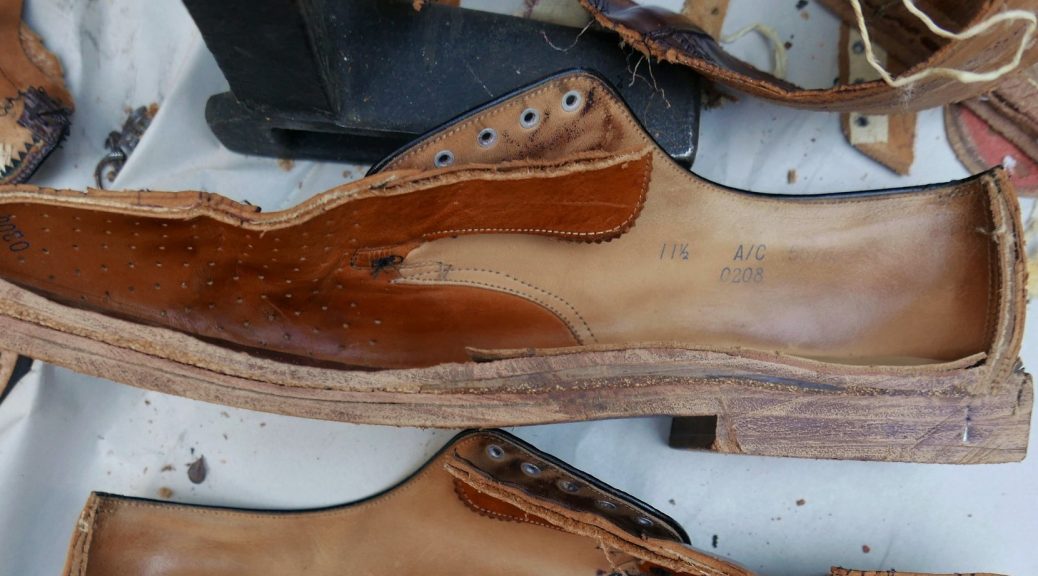


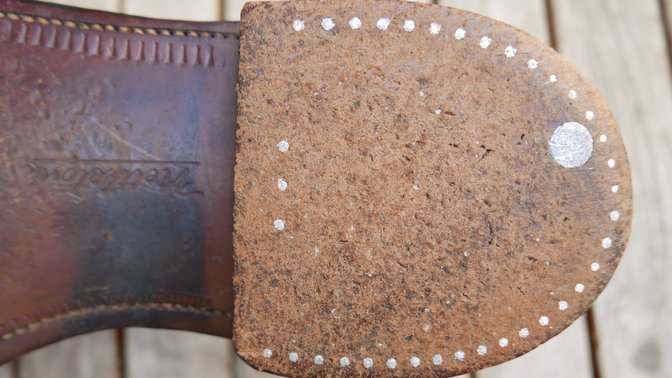






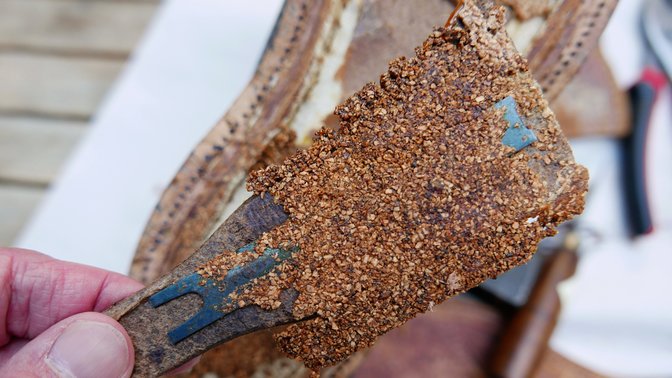


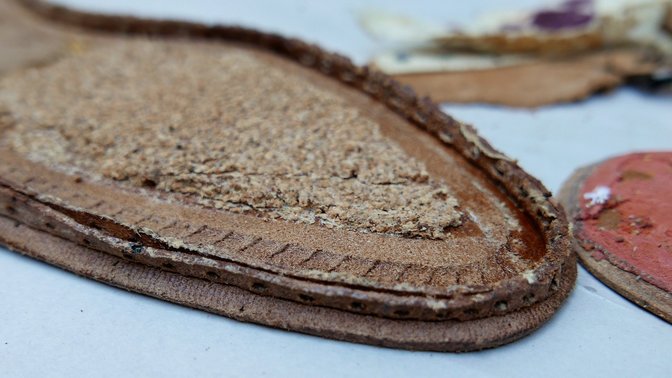
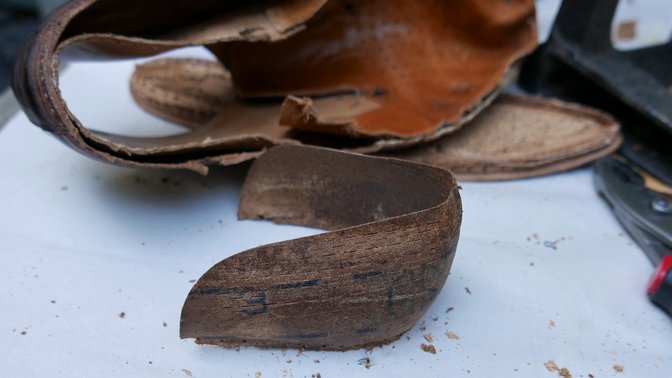



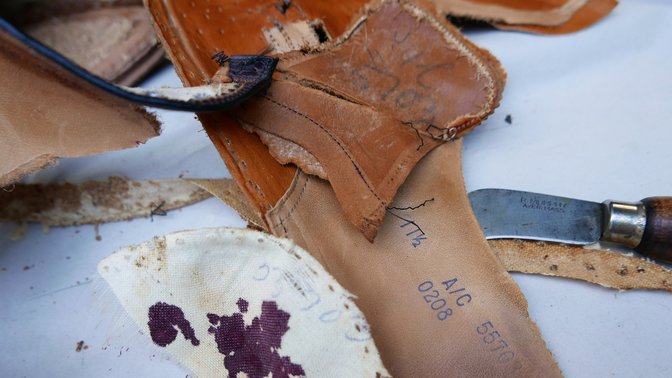




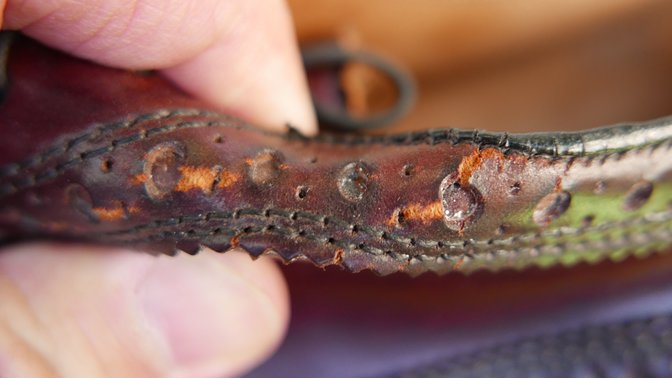

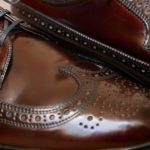
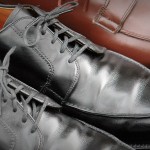
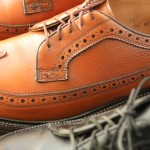
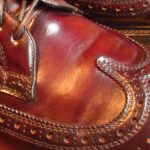
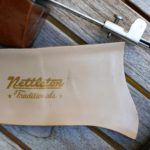
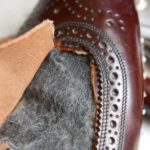
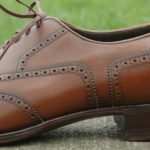
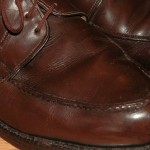
Well done, sir! I have a few pairs of failing she’ll that may meet similar ends.
Taking them apart was sort of fun. Definitely interesting.
Same thing happened to the only Nettleton I have ever found in my size. Vintage shell is tough…. Excellent write up as always.
Thank you
I love how you explain the grieving process of loosing a pair of shell shoes. So true!
Yeah, its happened a few times to me. Nothing you can do once they crack.
My heart was bleeding while watching such a beauty ended like that….:(
Maybe some day you will hack saw through a pair of steel toed Nettleton’s?
Ha. It seemed like an hour to do the full cut. Of course, I didn’t really know a good way of doing the cut. So there was some experimentation.
Fantastic article. Many thanks.
Thanks. It was fun to write.
Fun and interesting reading as always. Thanks Dave!
Thank you
Highly entertaining, and amusing, as usual. Nicely done.
Thanks Brett
Great post, David (and it’s been too long). What type of hydration did you do to these prior to wearing them?
None. My mistake was not conditioning them for 6 months. Conditioning might have delayed the cracking but maybe not. Normally I condition vintage Shell Cordovan with Bick 4 and/or Lexol NF.
Great article (as always) … And now I’m going straightaway to condition the only remaining pair of Nettleton shell LWB I have. 😎 (And I guess my shell saddles too) … I have always felt that Nettleton was a really well made shoe, reading thw comments about the construction and materials was great.
Thank you. Yes, keep them conditioned!
Really enjoyed the article as always… Sunday night treat.
I’ve often been intrigued about my shell – I only have 3 pairs: two Alden (PTB and LWB both in color 8) and my only vintage cordovan pair is some Hanover PTBs in black.
I’ve always thought that if you bought intact but dried out cordovan (say they’d been in a old man’s closet for decades) then they may be restorable to ‘new’ by intensive conditioning before use.
But I wonder now if, once they lose conditioning that they’re always going to fail at some point. It also makes me wonder about my contemporary Alden’s and if they should be getting a Lexol like drenching every couple of months even if they’ve not been worn.
What do you guys reckon, is there a way for shell to last indefinitely or is it always going to crack at some point no matter what you do? Last indefinitely if you know the shoe’s provenance – e.g bought new from Alden.
By comparison it appears that calf will last indefinitely if you keep it well looked after
Guess climate makes a difference, in rainy damp UK Manchester there’s not going to be an acrid ambient temperature but it’s an interesting and, given the cost of new shell, important matter to ponder.
That’s a good question. I have thought about it. At some point, I need to take a piece of dried out Shell Cordovan and see if conditioning stops further cracking.
I did something like that once. Took 2 dried pieces of shell from my 93605s and treated them with neatsfoot oil and regular lexol. After 2 days just lying flat in these substances shell didn’t change at all. The one treated with neatsfoot oil became even more fragile.
I applied a generous amount of Bick4 to one section and Lexol to another. I let them absorb for 30 minutes. Both sections continued to crack when pressure was applied to the broguing.
David
I had heard that the last owner decided not to sell out to a new company because he was worried that the new company would cheapen the shoes
I have a pair that I took leather soles off to install a Vibram Gumlite sole so that I could wear them due to my foot ailments. I Have out grown them and have thought about putting leather soles back on. Justvfor a display shoe. But I have lost the destinctive heel pads.
I did something similar on a range of shoes last summer, and somehow haven’t written up the results. It’s interesting to see!
Condolances on your pair, and it inspires me to put some conditioner on my vintage Florsheim pair that’s not getting much wear for about a year now…
i love and appreciate the respect you give vintage american footwear. i too collect and wear these shoes daily.
hard to find and even harder to say goodbye to.
thank you for keeping this website up and running.
i’ll be asleep on the couch in my workclothes…
Thank you
Another great article. Thanks!
I just purchased a pair of NOS never worn Florsheim 93606 PTB. They haven’t arrived yet, and I find myself facing the dilemma: do I preserve them as a museum piece, or do I wear them? And if I wear them (which I’m most likely to do), how do I prevent them suffering a fate like these cracked shell beauties?
Interesting article David and it shows just how well these shoes were made. I first found your site in pursuit of a pair of ‘Royals’ as they were called in Manchester UK in the early 70’s. I have now acquired multiple pairs of Florsheim Imperials and Aldens and and now appreciate Nettletons, which are even heavier.
Me also. The blog also introduced me to the delights of the heavy Nettletons. Ideal for pounding miserable rainy UK pavements.